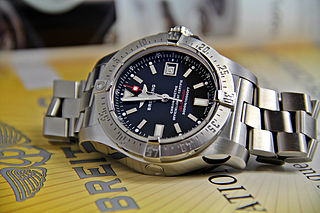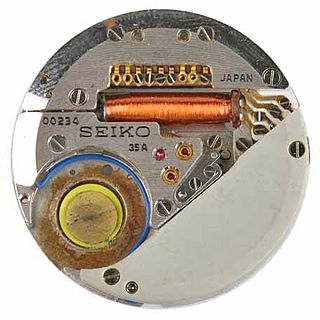Related Research Articles

A watch is a portable timepiece intended to be carried or worn by a person. It is designed to keep a consistent movement despite the motions caused by the person's activities. A wristwatch is designed to be worn around the wrist, attached by a watch strap or other type of bracelet, including metal bands, leather straps or any other kind of bracelet. A pocket watch is designed for a person to carry in a pocket, often attached to a chain.

Rolex SA is a British-founded Swiss watch designer and manufacturer based in Geneva, Switzerland. Founded in 1905 as Wilsdorf and Davis by Hans Wilsdorf and Alfred Davis in London, the company registered Rolex as the brand name of its watches in 1908 and became Rolex Watch Co. Ltd. in 1915. After World War I, the company moved its base of operations to Geneva because of the unfavorable economy in the United Kingdom. In 1920, Hans Wilsdorf registered Montres Rolex SA in Geneva as the new company name ; it later became Rolex SA. Since 1960, the company has been owned by the Hans Wilsdorf Foundation, a private family trust.

A clock face is the part of an analog clock that displays time through the use of a flat dial with reference marks, and revolving pointers turning on concentric shafts at the center, called hands. In its most basic, globally recognized form, the periphery of the dial is numbered 1 through 12 indicating the hours in a 12-hour cycle, and a short hour hand makes two revolutions in a day. A long minute hand makes one revolution every hour. The face may also include a second hand, which makes one revolution per minute. The term is less commonly used for the time display on digital clocks and watches.

Omega SA is a Swiss luxury watchmaker based in Biel/Bienne, Switzerland. Founded by Louis Brandt in La Chaux-de-Fonds in 1848, the company formerly operated as La Generale Watch Co. until incorporating the name Omega in 1903, becoming Louis Brandt et Frère-Omega Watch & Co. In 1984, the company officially changed its name to Omega SA and opened its museum in Biel/Bienne to the public. Omega is a subsidiary of The Swatch Group.

The Contrôle officiel suisse des Chronomètres (COSC), the Official Swiss Chronometer Testing Institute, is the institute responsible for certifying the accuracy and precision of Swiss watches.

Zenith SA is a Swiss luxury watchmaker. The company was started in 1865 by Georges Favre-Jacot in Le Locle in the canton of Neuchâtel and is one of the oldest continuously operating watchmakers. Favre-Jacob invented the concept of "in house movements", believing that only through control of the entire watchmaking process, could perfection be achieved. Zenith was purchased by LVMH in November 1999, becoming one of several brands in its watch and jewellery division which includes TAG Heuer and Hublot and is currently run by Julien Tornare as President and CEO.

Citizen Watch Co., Ltd. is an electronics company primarily known for its watches and is the core company of a Japanese global corporate group based in Nishitokyo, Tokyo, Japan. In addition to Citizen brand watches, it is the parent of American watch company Bulova, and is also known for manufacturing small electronics such as calculators.

The history of watches began in 16th-century Europe, where watches evolved from portable spring-driven clocks, which first appeared in the 15th century.

An automatic watch, also known as a self-winding watch or simply an automatic, is a mechanical watch where the natural motion of the wearer provides energy to wind the mainspring, making manual winding unnecessary if worn enough. It is distinguished from a manual watch in that a manual watch must have its mainspring wound by hand at regular intervals.

The Rolex Cosmograph Daytona is a mechanical chronograph wristwatch designed to meet the needs of racing drivers by measuring elapsed time and calculating average speed. Its name refers to Daytona, Florida, where racing flourished in the early 20th century. It has been manufactured by Rolex since 1963 in three distinct generations ; the second series was introduced in 1988, and the third in 2000. While cosmetically similar, the second series introduced a self-winding movement, and the third series brought manufacture of the movement in-house to Rolex.

A diving watch, also commonly referred to as a diver's or dive watch, is a watch designed for underwater diving that features, as a minimum, a water resistance greater than 1.0 MPa (10 atm), the equivalent of 100 m (330 ft). The typical diver's watch will have a water resistance of around 200 to 300 m, though modern technology allows the creation of diving watches that can go much deeper. A true contemporary diver's watch is in accordance with the ISO 6425 standard, which defines test standards and features for watches suitable for diving with underwater breathing apparatus in depths of 100 m (330 ft) or more. Watches conforming to ISO 6425 are marked with the word DIVER'S to distinguish ISO 6425 conformant diving watches from watches that might not be suitable for actual scuba diving.

A mechanical watch is a watch that uses a clockwork mechanism to measure the passage of time, as opposed to quartz watches which function using the vibration modes of a piezoelectric quartz tuning fork, or radio watches, which are quartz watches synchronized to an atomic clock via radio waves. A mechanical watch is driven by a mainspring which must be wound either periodically by hand or via a self-winding mechanism. Its force is transmitted through a series of gears to power the balance wheel, a weighted wheel which oscillates back and forth at a constant rate. A device called an escapement releases the watch's wheels to move forward a small amount with each swing of the balance wheel, moving the watch's hands forward at a constant rate. The escapement is what makes the 'ticking' sound which is heard in an operating mechanical watch. Mechanical watches evolved in Europe in the 17th century from spring powered clocks, which appeared in the 15th century.

A counterfeit watch is an unauthorised copy of an authentic watch. High-end luxury watches such as Rolex, Patek Philippe and Richard Mille are frequently counterfeited and sold on city streets and online. With technological advancements, many non-luxury and inexpensive quartz watches are also commonly counterfeited.

The quartz crisis was the upheaval in the watchmaking industry caused by the advent of quartz watches in the 1970s and early 1980s, that largely replaced mechanical watches around the world. It caused a significant decline of the Swiss watchmaking industry, which chose to remain focused on traditional mechanical watches, while the majority of the world's watch production shifted to Japanese companies such as Seiko, Citizen, and Casio which embraced the new electronic technology.

Boy Better Know, often abbreviated as BBK, is a British grime collective and record label. The collective was founded in North London in 2005 as an independent record label by brothers Jamie and Joseph Adenuga, better known as Jme, and Skepta. The first of them also serves as a sole owner and director of an associated company, Boy Better Know Limited, incorporated in 2008. All members of the collective use the record label as a means to publish their music, and is digitally distributed by The Orchard, a subsidiary of Sony Music.

Quartz clocks and quartz watches are timepieces that use an electronic oscillator regulated by a quartz crystal to keep time. This crystal oscillator creates a signal with very precise frequency, so that quartz clocks and watches are at least an order of magnitude more accurate than mechanical clocks. Generally, some form of digital logic counts the cycles of this signal and provides a numerical time display, usually in units of hours, minutes, and seconds.

Chief Joseph Olaitan Adenuga Jr., known professionally as Skepta, is a British-Nigerian grime MC, rapper and record producer. Alongside his younger brother Jme, he briefly joined Roll Deep before becoming founding members of Boy Better Know in 2005.

The Omega Seamaster is a line of mechanical, automatic winding, and chronometer diving watches that Omega has produced since 1948. The Seamaster was worn in the James Bond movie franchise since 1995. An Omega Seamaster typically has a stainless steel case and bracelet, screw-in crown and case-back, engraved with the Omega hippocampus logo, up to 1200-metre water resistant, luminescent hands, unidirectional bezel, blue, silver or black dial with orange accents, sapphire crystal (anti-reflective) and helium release valve.

Microphone Champion is the second studio album by English grime MC Skepta, released on 1 June 2009. It includes the single "Too Many Man" featuring Boy Better Know, also featured on Wiley's own album, Race Against Time, and Shorty's "Short Man Syndrome".

The Omega Electroquartz was introduced in 1969 as the first production Swiss quartz watch. It was the collaboration of 20 Swiss watch companies and the movement was utilised by Rolex, Patek Phillipe and Omega SA amongst others. The Beta 21 movement used in the Electroquartz was accurate to 5 seconds per month, far better than any automatic or manual wind movement of the day.